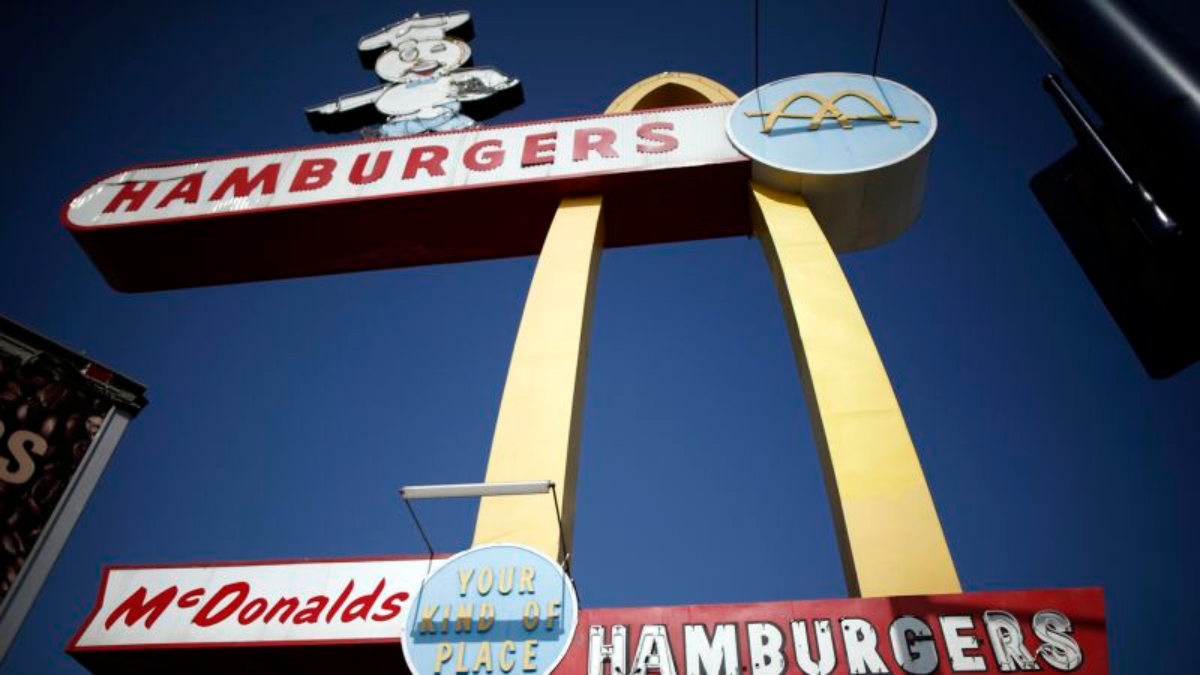McDonald's tests new automated delivery system 1:59
New York (CNN Business) --
For decades, bright, fun, and oddly shaped fast-food restaurants dotted the roadsides along America's highways.
You would drive by Howard Johnson's with its orange roofs then you would pass by the red-roofed huts of Pizza Hut.
A few more kilometers and there was the White Castle by the road with its towers.
Arby's roof was shaped like a boxcar and Denny's resembled a boomerang.
And then McDonald's, with its neon gold arches towering over its restaurants.
These wacky designs were an early form of brand advertising, gimmicks meant to grab the attention of drivers and get them to stop.
As fast food chains spread across the US after World War II, new roadside restaurant brands needed to stand out.
Television was a new medium that had not yet reached all homes, newspapers were still booming, and social networks were unimaginable.
So, restaurant chains turned to architecture as a key tool to promote their brand and help create their corporate identity.
advertising
Pizza Hut's red-roofed restaurants have been torn down and replaced with sleek new designs.
(Credit: Luke Sharrett/Bloomberg/Getty Images)
But today's fast food architecture has lost its quirky charm and distinctive features.
Changes in the restaurant industry, advertising and technology have made fast-food exteriors bland and spiritless, critics say.
Goodbye bright colors and unusual shapes.
Today, the design is minimal and flawless.
Most fast food restaurants are built to maximize efficiency, not to attract the attention of motorists.
Many are box-shaped, decorated with faux wood paneling, faux stone or brick exteriors, and flat roofs.
One critic calls this trend “fake five-star restaurants” aimed at making customers forget they're eating greasy burgers and fries.
The strings now look almost identical.
You could call it the gentrification of fast food design.
“They are soulless little boxes,” said Glen Coben, an architect who has designed boutique hotels, restaurants and shops.
"They're like Monopoly houses."
googie architecture
Fast food restaurants developed and expanded in the mid-20th century with the explosion of automobile culture and the development of interstate highways.
Big business came to dominate roadside restaurants through a strategy known as "product placement": the coordination of building design, décor, menu, service and pricing, according to John Jakle, author from “Fast Food: Roadside Restaurants in the Automobile Age.”
The buildings of fast food chains are designed to attract the attention of potential customers who are moving at high speeds and to get them to slow down.
“The buildings had to be visually strong and bold,” said Alan Hess, architectural critic and historian.
"That included neon signs and the shape of the building."
A prominent example: McDonald's design, with its two golden arches leaning over the roof of its restaurant, a style known as Googie.
A historic 1950s McDonald's restaurant in Downey, California in 2015. It is the oldest McDonald's still in existence.
(Credit: Lucy Nicholson/Reuters)
Introduced to California in 1953, McDonald's design was influenced by the ultramodern diners and roadside stands of Southern California, then the heart of fledgling fast food chains.
The two 25-foot bright yellow sheet metal arches that rose through the McDonald's buildings were tall enough to draw drivers in amid the clutter of other roadside buildings, its neon border glowed day and night.
The McDonald's design sparked a wave of Googie-style architecture at fast food chains across the country.
Until well into the 1970s, the designs were a prominent fixture of the American highway, "imbuing the image of fast-food drive-in architecture into the popular consciousness," Hess wrote in an article.
"Visual contamination"
But there was strong criticism of this aesthetic.
As the environmental movement developed in the 1960s, opposition to the conspicuous Googie style grew.
Critics called it "visual pollution."
“Critics hated this populist commercial California roadside architecture,” Hess said.
The Googie style fell out of fashion in the 1970s, as the fast-food style favored dark colors, brick and mansard roofs.
McDonald's new prototype became a low-profile, mansard roof and shingle-textured brick design.
Its arches once atop the building were translated into signage and became McDonald's corporate logo.
Opposition grew to garish structures like this Jack in the Box in 1970. (Credit: David F. Smith/AP)
"McDonald's and Jack in the Box displayed their neon and fluorescent signs and architectural containers against the endless sky," said the New York Times in 1978. They have "dimmed with the changing taste of the '60s and '70s."
And with the growth of mass communication advertising campaigns, brands no longer relied on architectural features to stand out, they could simply flood the television airwaves.
Fast food goes fancy
In the 1980s and 1990s, companies began introducing children's play areas and party rooms to appeal to families, additions to existing "brown" structures, Hess said.
The rise of mobile ordering and cost concerns since have disrupted modern fast food design.
With fewer people sitting down for full meals at fast food restaurants, businesses didn't need fancy dining rooms.
So today they're expanding drive-thru lanes, increasing the number of pickup windows, and adding digital kiosks in stores.
A Wendy's restaurant in 2020, an example of fast food design modernization.
(Credit: David Paul Morris/Bloomberg/Getty Images)
“We have a lot of red-roof restaurants” that “clearly need to go,” a Pizza Hut executive said in 2018 of its classic design.
The company's new prototype, "Hut Lanes," helps speed up wait times at self-service locations.
The new fast food box designs with their flat roofs are more efficient for heating and cooling than older structures, said John Gordon, a restaurant consultant.
Kitchens have been reconfigured to speed up food preparation.
They are also cheaper to build, maintain, and staff than a smaller store.
But in the effort to modernize, some say fast food design became homogenized and lost its creative purpose.
“I don't know if you'd be able to tell what they were if they had a different name on the front,” said Addison Del Mastro, an urban writer who documents the history of commercial landscapes.
"There is nothing that makes the imagination fly."
ArchitectureMcDonald'sPizza HutFast Food Restaurants












